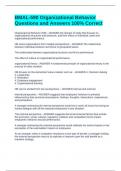BMAL-590 Organizational Behavior
Questions and Answers 100% Correct
Organizational Behavior (OB) - ANSWER-the domain of study that focuses on
organizational structures and protocols, and their effect on individual, team and
organizational performance.
OB views organizations from multiple perspectives: - ANSWER-The relationship
between individual behavior and those of groupsand teams.
The relationship between organizational structure and firm's performance.
The effect of culture on organizational performance.
organizational theory - ANSWER-A fundamental principle of organizational theory is the
process of value creation.
OB focuses on the elementsof value creation such as: - ANSWER-1. Decision making
2. Leadership
3. Motivation
4. Employee engagement
5. Organizational learning
OB can be studied from two perspectives: - ANSWER-internal and external
Internal perspective: - ANSWER-suggests that employees' behavior is primarily
influenced by their personal assumptions, feelings, thoughts, interactions, experiences,
and perceptions.
A manager embracing the internal perspective would try to solve all issues by having an
honest dialogue with all the impacted employees in any situation.
The external perspective - ANSWER-suggests that environmental factors that include
the economic, social, cultural, regulatory, political, and competitive forces impact
employees' behavior and job performance.
A manager embracing the external perspective would calibrate her actions based on her
perception of the externalities' impact on employees.
As an example, when a competitor introduces a new type of benefit, a manager holding
the external perspective may try to replicate or improve upon the said benefit as a
retention strategy.
,An Interdisciplinary Domain - ANSWER-It should be obvious from the preceding outline
that OB is not a monolithic domain or discipline of study.
OB draws from many disciplines to understand and explain individual and group
behavior.
OB draws from psychology while explaining why we behave the way we do.
OB draws from anthropology while understanding the evolution of behavior over time.
OB draws from sociology while exploring how households, families, and society interact
and lead to discernable patterns of behavior and tradition.
OB draws from engineering while examining measurement techniquesand productivity.
OB draws from statistics to understand trends and relationshipsbetween variables.
OB draws from medicine to recognize the importance of wellness and health.
Organization as a System - ANSWER-It is useful to view an organization as a system.
A system is a set of interrelated parts that work together towards a well-defined
objective.
Most systems have a control mechanism to correct and prevent deviation from the
desired level in system performance.
Control can be at the input, process, or output stage.
The output is one or more products, some waste, and information.
Feedback can be about quality, efficiency, or productivity.
Control would be steps to minimize deviations.
A system has some distinct characteristics: - ANSWER-One or more inputs
One or more processes that transform the inputs
One or more outputs
A feedback loop to measure efficiency and effectiveness
Inputs to an organizational system (manufacturing)include: - ANSWER-Capital
People
Raw materials
,Information
Technology
The processes may involve: - ANSWER-Physical
Chemical
Mechanical
Electronic
Assembly Lines
Test facilities
Systems and Subsystems - ANSWER-A typical system has many subsystems.
An organizational system, for example, has marketing, finance, manufacturing, service,
human resources, and technology subsystems.
Similarly, the organization itself is a part of a larger system that includes the political,
economic, social, and technological systems. (PEST)
Organization as a System - Baldrige Model - ANSWER-One of the widely used
frameworks or models for understanding and improving organizational systems is the
Baldrige Excellence Model.
Baldrige model has several subsystems: - ANSWER-Leadership
- the first subsystem, provides the mission, vision, objectives, and core values of the
organization.
* Mission- What is our business?
* Vision- What do we aspire to become?
* Objectives- How do we measure?
* Core Values- What do we believe in and stand for?
Strategy
- How do we succeed? By lowering costs? By offering something unique? By
operational excellence? By understanding and serving our customers? By combining all
of the above?
Customers
- Who are our customers? Where are they located?What are they looking for? What is
the "job to be done"? How do we offer what our customers want?Internal and External
customers.
Workforce
- the most important resource of an organization are its people. How to hire, orient,
train, motivate, compensate, develop, and retain a talented workforce?
Operations
, - How do we transform inputs into outputs better than competitors? How do we maintain
world-class quality? How do we provide exceptional service?
Results
- How do weMeasure success?Profits?Shareholder value? Market share? Customer
satisfaction Reputation? Brand recognition?
Results
- How do we Measure success? Profits? Shareholder value? Market share? Customer
satisfaction?Reputation? Brand recognition?
Core Values
- What do we stand for? Honesty? Integrity? Fairness? Empathy? Service Above Self?
The Golden Rule? Our Ethical and Moral Compass
Robert Katz - ANSWER-identified three types of skills as being critical for organizational
success.
Technical
Human
Conceptual
Technical skills are important at the entry level.
Conceptual skills are important at the leadership level.
Human or Interpersonal skills are critical at every level. To understand human skills, we
need to study OB.
Henri Fayol conceived of five management functions. Today, these have been reduced
to four: - ANSWER-Plan
Organize
Lead
Control
Plan: - ANSWER-How do we achieve organizational objectives?
How do we allocate resources - money, materials, and people?
How do we set timelines for achieving our goals?
How do we prioritize all that we need to do?
Organize: - ANSWER-What processes are required in our organization?
Who is responsible for each of the processes?




